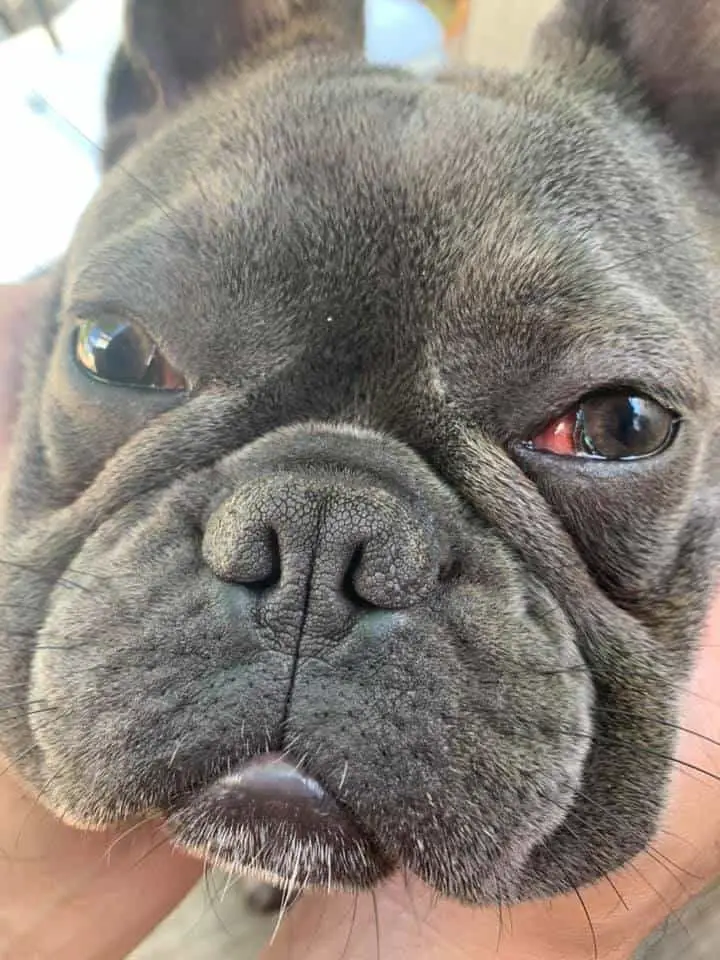Dog owners know that their pets can be afflicted by any and all sorts of health issues, and this is especially true in certain breeds. Frenchies, who are prone to a wide variety of health ailments, not limited to obesity, allergies, tail pocket issues, or even deafness, also commonly suffer from another issue: cherry eye.
French Bulldog cherry eye is a condition in which a red, inflamed mass protrudes from the eye. But what is the cause of this odd-looking affliction, and how can it be treated?
What Causes French Bulldog Cherry Eye?
Unlike humans, dogs have a “third eyelid” also known as their nictitating membrane. Often, you can observe this eyelid while sleeping; it is a red membrane that rolls across the eye and might make your Frenchie look like he’s rolling his eyes toward the back of his head.
Your pet’s nictitating membrane serves a very important purpose: to keep debris out of the eye, fight off infection, and produce tears.
Cherry eye occurs when the tear gland of the nictitating membrane pops out of position so that it is visible outside of the eye. Most commonly, cherry eye effects younger dogs (around 2 years or younger), but it can occur in dogs of any age.

How To Know If Your Dog Has Cherry Eye
Usually, it will be pretty easy to determine whether or not your dog is suffering from cherry eye, as a large red sack will be sticking out of their eyeball.
That being said, there are some symptoms to look out for to determine if your pet is suffering from bulldog cherry eye. If you keep an eye out for these symptoms, you can be sure your Frenchie gets the medical attention they need right away.
- Swollen, red mass sticking out from the eye (called a cherry pit)
- Overproduction of tears/draingage from the eye
- Dry eyes
- Impared vision
- Rubbing or scratching of the eye
- squinting
If you notice any of these symptoms in your pet, it’s important that you take them to see their veterinarian as soon as possible. Often times, the symptoms of cherry eye cause a significant amount of pain or discomfort, and the earlier your pet is taken in, the better their prognosis.
Treatment of Cherry Eye
If your pet is, unfortunately, suffering from the unmistakable cherry eye, as stated above, it’s important to get them to the vet as soon as possible.
When it comes to the treatment of cherry eye there are two options, and your vet will have to determine which one is right for your pet.
The first option is non-surgical. Sometimes, cherry eye will go away on its own, although this is very rarely the case. However, if your vet determines that surgery isn’t immediately necessary, they will provide other alternatives.
Anti-inflammatory eye drops can be used to relieve the pain and discomfort your dog is feeling, as well as reduce swelling and inflammation. Topical antibiotic ointments can also be used when there’s a lot of discharge, and to protect against secondary infections.
Other than this, sometimes massage is used to slowly move the gland back into position.
If your vet determines that surgery is the best option for your French Bulldog cherry eye, there are a few methods they might try.
The first of these methods is the tucking method, in which a permanent stitch is used to pull the gland back into its original position. Or, with the fabrication method, your vet will remove a wedge of tissue from the gland, although this method is considered more difficult.
Finally, if all else fails, your vet may have to remove the tear gland completely. This, however, is far from ideal, as your Frenchie will be unable to produce the necessary tears to keep their eye most. Because of this, they will need daily eyedrops administers to them. If you don’t have pet insurance on your Frenchie yet, you should look into it.
Complications of Untreated Cherry Eye
As stated numerous times, it’s important to get your dog to the vet as soon as you know they’re suffering from cherry eye. This is because, when it goes untreated, there is a long list of complications that can arise.
The most common of these complications is dry eye, but they can be more serious. In fact, blood flow to your Frenchie’s nictitating membrane can become restricted.
Furthermore, if left untreated for longer periods of time, inflammation and swelling will persist, seriously comparing their vision.
Causes Of Bulldog Cherry Eye
The cause of cherry eye, particularly in French Bulldogs, is not 100% known, but there are some ideas floating around.
For starters, there is likely a genetic cause that is passed from parents to puppies. Furthermore, tissue fibers that hold the nictitating membrane’s gland in place can weaken, causing it to pop out of place.
Some breeds, like Frenchies, have a higher genetic predisposition to this weakened tissue fiber, which makes them more susceptible to cherry eye.
Also, as previously stated, cherry eye is much more common in young dogs, particularly those who are younger than two years of age. While experts are not sure why this is the case, if your Frenchie is older than two, they are at far less risk of contracting cherry eye.

In Summary on French Bulldog Cherry Eye
French Bulldog red eyes do not always constitute cherry eyes, it’s important to stay cognizant of your pet’s eyes. Cherry eye can appear rather quickly, and if you’re not on top of it, it can quickly worsen.
If your French Bulldog red eyes are a concern to you, you can always consult your veterinarian. Sometimes, they just need some eye drops to make sure that their eyes aren’t drying out.
In any case, as long as you pay attention to your pet, and give them all the love and care they deserve, they will live long, happy, healthy lives, and you will be able to cuddle them for many years to come!




